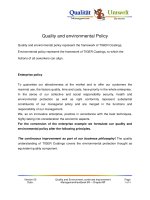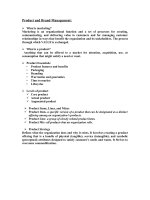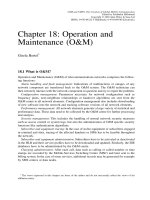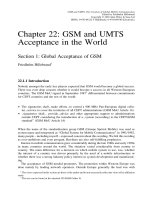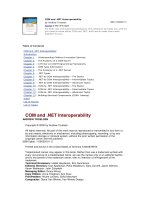Tài liệu Diseases and Disorders AIDS doc
Bạn đang xem bản rút gọn của tài liệu. Xem và tải ngay bản đầy đủ của tài liệu tại đây (12.38 MB, 113 trang )
D
iseases and
D
isorders
AIDS
by Sudipta Bardhan-Quallen
Detroit • New York • San Francisco • San Diego • New Haven, Conn.
Waterville, Maine • London • Munich
© 2005 Thomson Gale, a part of the Thomson Corporation.
Thomson and Star Logo are trademarks and Gale and Lucent Books are registered trademarks used
herein under license.
For more information, contact
Lucent Books
27500 Drake Rd.
Farmington Hills, MI 48331-3535
Or you can visit our Internet site at
ALL RIGHTS RESERVED.
No part of this work covered by the copyright hereon may be reproduced or used in any form or by any
means—graphic, electronic, or mechanical, including photocopying, recording, taping, Web
distribution, or information storage retrieval systems—without the written permission of the publisher.
Every effort has been made to trace the owners of copyrighted material.
Printed in the United States of America
LIBRARY OF CONGRESS CATALOGING-IN-PUBLICATION DATA
Bardhan-Quallen, Sudipta.
AIDS / by Sudipta Bardhan-Quallen.
p. cm. — (Diseases and disorders)
Includes bibliographical references and index.
Contents: The origins of an epidemic—Anatomy of an infection—New weapons
against HIV—A global epidemic—The dream of a vaccine—The future of AIDS.
ISBN 1-59018-404-1 (hard copy : alk. paper)
1. AIDS (disease)—Juvenile literature. I. Title. II. Series: Diseases and disorders series.
RC606.65.B37 2004
616.97'92—dc22
2004010197
On cover: On World AIDS day, December 1, 2003, people in the
Philippine Islands light candles to commemorate victims of AIDS.
Foreword 4
Introduction
Everybody’s Problem 6
Chapter 1
The Origins of an Epidemic 11
Chapter 2
Anatomy of an Infection 24
Chapter 3
New Weapons Against HIV 36
Chapter 4
A Global Epidemic 49
Chapter 5
The Dream of a Vaccine 62
Chapter 6
The Future of AIDS 73
Notes 85
Glossary 89
Organizations to Contact 92
For Further Reading 96
Works Consulted 98
Index 105
Picture Credits 111
About the Author 112
Table of Contents
4
“The Most
Difficult Puzzles
Ever Devised”
C
HARLES BEST, ONE of the pioneers in the search for a cure for
diabetes, once explained what it is about medical research
that intrigued him so. “It’s not just the gratification of knowing
one is helping people,” he confided, “although that probably is a
more heroic and selfless motivation. Those feelings may enter in,
but truly, what I find best is the feeling of going toe to toe with
nature, of trying to solve the most difficult puzzles ever devised.
The answers are there somewhere, those keys that will solve the
puzzle and make the patient well. But how will those keys be
found?”
Since the dawn of civilization, nothing has so puzzled people—
and often frightened them, as well—as the onset of illness in a
body or mind that had seemed healthy before. A seizure, the in-
ability of a heart to pump, the sudden deterioration of muscle
tone in a small child—being unable to reverse such conditions or
even to understand why they occur was unspeakably frustrating
to healers. Even before there were names for such conditions, even
before they were understood at all, each was a reminder of
how complex the human body was, and how vulnerable.
While our grappling with understanding diseases has been
frustrating at times, it has also provided some of humankind’s
most heroic accomplishments. Alexander Fleming’s accidental
discovery in 1928 of a mold that could be turned into penicillin
Foreword
Foreword
5
has resulted in the saving of untold millions of lives. The isola-
tion of the enzyme insulin has reversed what was once a death
sentence for anyone with diabetes. There have been great strides
in combating conditions for which there is not yet a cure, too.
Medicines can help AIDS patients live longer, diagnostic tools
such as mammography and ultrasounds can help doctors find
tumors while they are treatable, and laser surgery techniques
have made the most intricate, minute operations routine.
This “toe-to-toe” competition with diseases and disorders is
even more remarkable when seen in a historical continuum. An as-
tonishing amount of progress has been made in a very short time.
Just two hundred years ago, the existence of germs as a cause of
some diseases was unknown. In fact, it was less than 150 years ago
that a British surgeon named Joseph Lister had difficulty persuad-
ing his fellow doctors that washing their hands before delivering a
baby might increase the chances of a healthy delivery (especially if
they had just attended to a diseased patient)!
Each book in Lucent’s Diseases and Disorders series explores
a disease or disorder and the knowledge that has been accumu-
lated (or discarded) by doctors through the years. Each book also
examines the tools used for pinpointing a diagnosis, as well as
the various means that are used to treat or cure a disease. Finally,
new ideas are presented—techniques or medicines that may be
on the horizon.
Frustration and disappointment are still part of medicine, for
not every disease or condition can be cured or prevented. But the
limitations of knowledge are being pushed outward constantly;
the “most difficult puzzles ever devised” are finding challengers
every day.
6
Introduction
Everybody’s
Problem
L
ONG BEFORE THE disease called AIDS was known by that name,
an epidemic had begun. This deadly scourge that has ravaged
the world began in the 1950s with isolated cases detected in Eu-
rope and Africa. The main symptoms were strange infections that
should not have been life threatening but nonetheless proved fa-
tal. For example, Dr. Margrethe Rask became ill with a breathing
disorder in Zaire in 1976; though it was clear she was dying, nei-
ther she nor any other doctor could determine the reason. After
Rask’s death in December 1977, an autopsy revealed that she had
been slowly suffocated by the growth of millions of microorgan-
isms called Pneumocystis carinii in her lungs. Pneumonia caused
by this microbe was rare, and as far as doctors knew, no one died
of such infections.
By the 1970s, dozens of these unexplained cases were appearing
in major cities in Europe and Africa, puzzling doctors who treated
the dying patients. By 1979, it had spread to the United States and
the rest of the world. Within a few short years, people were dying
by the thousands. Doctors concluded that a new disease was to
blame for the previously inexplicable deaths, but this conclusion did
not offer any hope for treatment.
In 1982, the mysterious disease was finally given a name—
acquired immune deficiency syndrome, or AIDS. In the span of
a few years, AIDS went from an unknown disease to a household
name, taking a tremendous human toll in the process—and that
was just the beginning.
The Face of Suffering
Throughout the 1980s, AIDS spread virtually unchecked, in part
because the earliest victims, primarily homosexual men and in-
travenous drug users, lived on the margins of society. Some peo-
ple were quick to characterize AIDS as a punitive disease visited
upon those who were, in their opinions, immoral or depraved. For
example, American televangelist Reverend Jerry Falwell said with
reference to homosexuality, “AIDS is a lethal judgment of God
on America for endorsing this vulgar, perverted and reprobate
lifestyle.”
1
A number of organizations in the United States vigor-
ously opposed government funding of AIDS research on the as-
sumption that the disease was a problem of so-called deviants.
Those who engaged in heterosexual relations and did not take
drugs intravenously, the thinking went, had little to fear from AIDS.
Everybody’s Problem
7
At a 1983 AIDS vigil in New York City’s Central Park, people hold numbered
signs, each representing a victim of the worldwide AIDS epidemic.
Over time, however, AIDS did not stay confined to groups that
could be dismissed as outside the mainstream. In fact, the virus
that causes AIDS, human immunodeficiency virus (HIV), was
shown to infect victims without regard to gender, age, race, sex-
ual orientation, or social status. By 2004, worldwide heterosexual
contact—not homosexual sex or intravenous drug use—became
responsible for 90 percent of all adolescent and adult HIV infec-
tions. Women became a significant portion of those with HIV in-
fections, as did babies born to infected mothers. In little more than
AIDS
8
This malnourished Ethiopian boy was born infected with AIDS. Infected
babies born to infected mothers make up a significant percentage of AIDS
cases around the world.
two decades the HIV/AIDS epidemic spanned the globe and af-
fected people regardless of varying cultures and lifestyles.
A Growing Problem
The near-universal vulnerability to infection and the lack of any
cure meant that AIDS would become a major killer. Indeed, AIDS
has become the fourth-leading cause of death around the world,
claiming more lives than cancer, malaria, tuberculosis, or diabetes.
Experts estimate that every day, sixteen thousand people globally
are infected with HIV, and that 42 million people are living with
HIV or AIDS. It is now clear that AIDS cannot be considered some-
one else’s problem.
With the huge increase in HIV cases, efforts to prevent trans-
mission of the virus have become a concern for everyone. Said Dr.
Sharon Hillier of the University of Pittsburgh School of Medicine,
“The issue of HIV prevention is not a gay issue or a women’s is-
sue—it’s a human issue.”
2
Making people aware of the disease and
of how they could reduce their risk of contracting AIDS became a
priority for the U.S. government. In fact, in 1988, the U.S. govern-
ment spent $17 million to mail Surgeon General C. Everett Koop’s
pamphlet, Understanding AIDS, to 107 million households in the
country. Efforts of this sort are ongoing. As of 2004, millions of dol-
lars are spent each year for HIV education around the world.
A Glimmer of Hope
In addition to HIV education and prevention, many resources are
being devoted to research into treating the disease as well as into
making treatments available globally. The most significant advance
in HIV/AIDS treatment since the disease was identified is simply
that doctors now have treatments to offer. In 1982, the year AIDS
was given its name, doctors could offer AIDS patients no med-
ical treatments. The best they could do was battle the infections
that arose due to the destroyed immune system—a battle that doc-
tors and their patients always eventually lost. Though there is still
no cure for HIV infection, patients today have hope in the form
of a variety of drugs that better protect the immune system from
being ravaged by HIV.
Everybody’s Problem
9
These treatments have begun to change HIV infection from a
terminal to a chronic illness—that is, one that can be controlled and
that does not necessarily kill its victim. However, the drugs do not
work for every patient; moreover, they are not equally available
throughout the world. Because of the limitations in the effective-
ness of current treatments, scientists continue to push forward to
search for new HIV therapies, including vaccines and gene ther-
apy. Many scientists feel that a cure for AIDS is possible by 2025,
but, in the words of leading AIDS researcher Dr. David Ho, direc-
tor of the Aaron Diamond AIDS Research Center in New York City,
“It will require an extraordinary effort of political will among our
leaders to get it to the people who need it most.”
3
AIDS
10
The Origins of an
Epidemic
I
N MOST OF the world, AIDS was not recognized as a problem in its
own right until around 1981—decades after the disease first arose
in humans. Scientists now think that AIDS became evident in humans
as early as the 1950s, in Europe and Africa, although proper diagnoses
were not made at the time. Since AIDS escaped detection for so long,
it is impossible to say how many people died of AIDS-related illnesses
in the years before doctors became familiar enough with the disease
to identify it in patients. In fact, before 1981, most people had never
even heard of the disease—and no one understood how it killed.
Awareness of a looming epidemic was growing rapidly by the
end of 1982. Over sixteen hundred cases of AIDS had been diag-
nosed in the United States; over six hundred Americans had died
of the disease. Because of the increased awareness and the evident
threat to public health, major initiatives were quickly taken to in-
crease understanding of AIDS and to improve diagnostic techniques.
Doctors at the federal government’s Centers for Disease Control and
Prevention (CDC) worked to track and understand the progression
of the disease in individual patients. The goal was to recognize symp-
toms of AIDS, thereby helping with diagnosis. In addition, scien-
tists worldwide sought to isolate the microorganism that causes
AIDS and to develop an effective blood test for diagnosis.
The Beginning
In the United States, awareness of the AIDS epidemic can be traced
back to a 553-word article, simply titled “Pneumocystis Pneumonia—
Los Angeles.” The article appeared in the June 5, 1981 issue of the
11
Chapter 1
Morbidity and Mortality Weekly Report (MMWR), the CDC’s weekly
newsletter aimed at informing health care professionals of current med-
ical concerns. The report did not mention a previously unknown virus;
instead, authors Dr. Michael Gottlieb and Dr. Wayne Shandera wrote:
In the period October 1980–May 1981, 5 young men, all active
homosexuals, were treated for biopsy-confirmed Pneumocystis
carinii pneumonia (PCP). . . . The fact that these patients were all
homosexuals suggests an association between some aspect of a
homosexual lifestyle or disease acquired though sexual contact
and Pneumocystis pneumonia in this population.
4
Gottlieb’s and Shandera’s patients were dying, apparently of
PCP, even though PCP was a generally treatable disease that sel-
dom proved fatal. The patients showed other strange symptoms
as well: swollen lymph nodes, fevers, weight loss, oral yeast in-
fections, and elevated levels of cytomegalovirus (CMV), a virus
that normally causes no adverse symptoms but which in these pa-
tients seemed to overwhelm the body. In addition, these patients
suffered from reductions in counts of T cells, which are vital for
the immune system’s proper function.
In the ensuing months, more cases of strange sicknesses among
homosexual men were reported. In addition to cases of PCP, doc-
AIDS
12
In 1981 several homosexual men died of a normally treatable form of
pneumonia caused by the bacteria Pneumocystis carinii (pictured). Doctors
speculated that a new disease made them susceptible to the pneumonia.
tors saw young men in their twenties and thirties suffering from
a rare skin cancer called Kaposi’s sarcoma (KS). Many doctors con-
jectured that the unusual illnesses were linked in some way, and
the CDC issued a warning to physicians: “Physicians should be
alert for Kaposi’s sarcoma, PC pneumonia, and other opportunis-
tic infections associated with immunosuppression in homosexual
men.”
5
By the end of 1981, 422 cases of the syndrome, that is, a
group of symptoms that collectively characterize a disease, were
reported in the United States alone, with 156 people dead—and
still, no one knew the cause.
An increase in the number of homosexual men with the rare skin cancer
Kaposi’s sarcoma (pictured) provided further evidence that a new disease was
spreading throughout the gay community.
Following the Trail
When the CDC began studying the syndrome, it became imme-
diately clear that a hallmark was a loss of immune function that
allowed the development of opportunistic infections—illnesses
that would have never occurred had the immune system been
functioning properly. More and more patients were diagnosed
with the same strange maladies: yeast infections, toxoplasmosis
(a rare parasitic disease that usually causes no negative symptoms
in healthy people), infections from cryptococcosis (a fungus com-
monly found in bird droppings), CMV infections, as well as KS
and PCP. Awhole host of other rare illnesses were also soon added
to the list. Doctors reported patients afflicted with the syndrome
were showing signs of diseases as exotic as feline leukemia, a ma-
jor cause of death in cats, and cryptosporidiosis, a parasitic dis-
ease usually seen only in sheep and goats. It appeared that these
patients’ immune systems were so compromised that microor-
ganisms usually unable to infect humans at all were able to cre-
ate life-threatening infections.
Another seemingly consistent feature was that the syndrome
appeared to affect only homosexual men; in fact, it seemed that
the more promiscuous the subject, the more likely he was to be-
come infected. In a New York Times article, Dr. James Curran of
the CDC stated that heterosexual men and women, regardless
of sexual orientation, were apparently safe from the syndrome:
“The best evidence against contagion is that no cases have been
reported to date outside the homosexual community or in
women.”
6
With this assumption in mind, in January 1982, the
syndrome was named gay-related immunodeficiency disease, or
GRID.
Doctors at the CDC looked for connections between the victims
of GRID, in an effort to establish the disease’s mode of transmis-
sion. From interviewing victims, they were soon able to estab-
lish social and sexual connections between people who later
developed symptoms of GRID. Of the first nineteen cases of GRID
investigated, sexual links were confirmed between nine of them.
The suspicion arose that whatever was causing GRID was trans-
mitted sexually.
AIDS
14
Cancer, a Virus, and GRID
Scientists already knew that certain infections could result in
immune suppression; moreover, there were viruses that had
been identified that did just that. Certain cancers had also been
linked to viral infections, and these cancers sometimes inter-
fered with proper immune function. For example, the human
T cell leukemia virus (HTLV) had been shown in 1980 to be a cause
of T cell leukemia in Japan and the Caribbean. Patients with T cell
leukemia, like those with GRID, experienced severe drops in
T cell counts.
Some researchers at the CDC supported the notion that GRID
also was caused by a virus. This had ominous implications: Viruses
do not consider sexual orientation when they infect a host. If a
virus was causing GRID, there was no reason to believe that the
contagion would stay confined to the relatively small population
of homosexuals. Scientists predicted that the epidemic would soon
spread to people outside the gay community.
Drug Addicts, Hemophiliacs, and Children
The prediction turned out to be correct. As early as mid-1981, doc-
tors had noticed symptoms in intravenous drug users that in hind-
sight were consistent with GRID. By early 1982, at least twenty-three
heterosexuals, mostly intravenous drug users, were counted among
GRID victims.
Many scientists felt that the infections seen in intravenous drug
users suggested that GRID could be spread through the blood as
well as through sexual contact, and that it was more likely to have
a viral cause. Since intravenous drug users often shared needles,
they were exposed to the blood of other drug users. This means
of disease transmission was well known. The blood contact
spread diseases such as hepatitis B, which was caused by a virus.
The theory that GRID was spread through blood contact got fur-
ther corroboration when a number of people with hemophilia be-
gan showing symptoms. Hemophiliacs, who have a blood disorder
that prevents proper clotting following injury, often require trans-
fusions and injections of the components their own blood lacks. In
The Origins of an Epidemic
15
early 1982 in Miami, an elderly man with hemophilia was diag-
nosed with Pneumocystis. He was not an intravenous drug user,
but because of the hemophilia, he received regular injections of a
clotting agent. The clotting agent, isolated from the blood of non-
hemophiliac blood donors, is called Factor VIII.
The man’s doctor initially believed that Pneumocystis carinii mi-
croorganisms might have contaminated the patient’s doses of Fac-
tor VIII. Bruce Evatt at the CDC, however, assured the physician
that these bacteria were large enough that they would have been
completely filtered out during the process of Factor VIII isolation.
Only very small microbes, such as viruses, could pass through the
filtering process.
AIDS
16
Teenager Ryan White and many other hemophiliacs contracted AIDS in the
mid-1980s, confirming the theory that AIDS could spread through blood contact.
The number of nonhomosexual GRID cases continued to rise.
By mid-1982, two more hemophiliacs were confirmed to have
GRID. Infected intravenous drug users were also becoming more
common. Furthermore, there were reports of children of GRID-
infected drug addicts showing GRID symptoms from birth. One
account told of a seventeen-month-old baby who had oral yeast
infections, staphylococcus aureus infections, and an infection of a
bacterium called Mycobacterium avian-intracellular, which was usu-
ally only seen in birds. Another thirty-week-old infant was suf-
fering from infections including PCP, cryptococcosis, and CMV—all
hallmarks of GRID. Soon, doctors at the CDC were forced to con-
clude that GRID was not purely a homosexual disease. Further-
more, the fact that babies could be born with the disease made it
clear that, although lifestyle was a risk factor, virtually anyone could
contact GRID. As this fact became clear, scientists redoubled their
efforts to find the cause of GRID.
A New Name and a New Fear
In light of the new information regarding who was at risk, the name
“gay-related immunodeficiency disease” seemed inappropriate.
Curran argued that a more neutral name should be given to the
disease. He later recalled, “By now there had been reports of cases
in injecting drug users, and in women who were sex partners of
men with AIDS, so it was time to describe it more broadly.”
7
After
some discussion, a new name was proposed: “acquired immune
deficiency syndrome,” or AIDS. The new name implied a greater
risk for the population at large, and more of the public began to
take interest in the AIDS situation.
Much of the interest was sparked when a new source of fear
concerning AIDS was identified: Blood banks could and had been
providing infected blood to unsuspecting patients. The first known
case of transfusion-related infection came in 1983, when a fifty-
three-year-old man was diagnosed with AIDS. He was not a ho-
mosexual, an intravenous drug user, or a hemophiliac, but he had
undergone open-heart surgery twenty-nine months before the di-
agnosis. During his surgery, doctors had given him blood trans-
fusions.
The Origins of an Epidemic
17
When more transfusion recipients—thirty-nine of them by the
end of 1983—began showing AIDS symptoms soon after they had
received blood, the list of who was at high risk for contracting AIDS
was greatly expanded. Dr. Harold Jaffe of the CDC described the sit-
uation: “When it began turning up in children and transfusion re-
cipients, that was a turning point in terms of public perception. Up
until then it was entirely a gay epidemic, and it was very easy for
the average person to say ‘So what?’ Now everyone could relate.”
8
AIDS
18
A patient receives a blood transfusion. Because the microorganism responsible
for AIDS had not been identified in the early 1980s, blood banks unwittingly
supplied tainted blood.
Infected Blood
It became more difficult to argue that AIDS was not in the blood.
Yet even though the medical evidence suggested that AIDS could
be transmitted through blood contact, there was still a great deal
of resistance to that theory, especially from the blood banks, many
of which sold blood for a profit. If blood banks admitted that their
product might be infected, there would be serious financial reper-
cussions for the entire industry.
The problem was having no way to test blood for a microorgan-
ism that had not yet been identified. As a stopgap measure, in 1983,
the CDC proposed that blood products be tested for hepatitis B, cit-
ing the fact that an overwhelming number of people in the highest
risk groups for AIDS—gay men, hemophiliacs, and intravenous
drug addicts—had also at some point contracted hepatitis B. In fact,
88 percent of homosexual AIDS patients, 80 percent of hemophiliac
AIDS patients, and virtually 100 percent of intravenous drug–addict
AIDS patients tested positive for hepatitis B. Removing hepatitis
B–positive blood from the supply could therefore be expected to re-
duce the risk of a recipient contracting AIDS.
The blood-banking industry, however, rejected the plan outright.
Dr. Aaron Kellner, president of the New York Blood Center, stated
that the cost of testing was prohibitive; he estimated the national
cost to perform hepatitis B tests would be $100 million annually.
He contended that the small number of AIDS cases that resulted
from tainted blood was not enough to justify such an expensive
course of action: “We must be careful not to overreact. The evidence
[that the blood supply may be seriously tainted] is tenuous.”
9
The Virus Hunt
With the increase in the number of people perceived to be at risk
for contracting AIDS, scientists both in the United States and else-
where knew that answers to the fundamental problems of the epi-
demic—what causes AIDS and how doctors could diagnose the
disease before a victim spreads it—had to be found, and quickly.
Researchers at the National Institutes of Health (NIH) in Bethesda,
Maryland, and at the Pasteur Institute in Paris followed seemingly
unrelated trails in search of the virus that caused AIDS.
The Origins of an Epidemic
19
At NIH, Dr. Robert Gallo headed the team that was hunting
for the AIDS virus. Gallo was an expert in retroviruses, a class of
virus whose genes are stored, not as deoxyribonucleic acid (DNA),
but as ribonucleic acid (RNA), another type of genetic material. He
had identified the only two retroviruses scientists knew of, HTLV-
1 in 1979 and HTLV-2 in 1982, both of which were involved in hu-
man T cell leukemia. Since that disease also greatly affected T cells,
Gallo had long contended that AIDS was also caused by a retro-
virus, similar to HTLV-1 and HTLV-2. Despite this promising the-
ory, Gallo and his team had made very little progress in actually
identifying the cause of AIDS. By early 1983, they had examined
blood samples from thirty-three AIDS patients but had found
HTLV-related genetic material in only two of them.
A Major Breakthrough
In the meantime, scientists at the Pasteur Institute had experienced
greater success. Dr. Luc Montagnier was in charge of the AIDS
research effort at the Pasteur Institute. Using a tissue sample from
a French AIDS patient, Montagnier attempted to grow the AIDS
virus in a laboratory culture of human T cells. Fifteen days later,
the cell culture showed traces of a protein called reverse tran-
scriptase that is used by retroviruses when they proliferate in host
cells.
Montagnier was able to isolate the virus from the tissue sam-
ple and compare it to other previously identified retroviruses. He
was sure that the AIDS patient’s virus was different from anything
seen before. In May 1983, Montagnier announced his discovery
of the AIDS retrovirus, which he later named lymphadenopathy-
associated virus (LAV). Montagnier, however, was not able to
prove conclusively that LAV actually caused AIDS. Gallo’s group,
meanwhile, had finally isolated a retrovirus they called HTLV-3
in the blood of AIDS patients. In 1984, they were able to demon-
strate a strong correlation between its presence and the onset of
AIDS symptoms.
It was eventually shown that LAV and HTLV-3 were the same
virus. Since both research teams had worked on the discovery and
made important contributions, Gallo and Montagnier agreed to
AIDS
20
share credit for discovering the virus that causes AIDS. Rather than
choose between the names LAV or HTLV-3, in early 1987, an in-
ternational committee renamed the organism human immuno-
deficiency virus, or HIV.
Test Results
By the time the AIDS virus was renamed HIV, a number of scien-
tists had developed tests to screen for its presence in blood sam-
ples. These tests were slightly different from each other, and none
detected the virus itself; rather, they detected the presence of an-
tibodies to HIV, which the immune system creates in response to
exposure to the virus.
The Origins of an Epidemic
21
Working independently, American doctor Robert Gallo (right) and French doctor
Luc Montagnier both managed to isolate HIV, the virus that causes AIDS.
The newly developed HIV tests were widely used to screen read-
ily available blood bank samples as well as individuals concerned
that they might have contracted HIV. In 1985, after the U.S. Food
and Drug Administration (FDA) approved a blood-screening test
for HIV, the American Red Cross reported that one in five hundred
American blood donors was a carrier of HIV. Even more alarming,
because millions of people had received blood tranfusions since the
beginning of the AIDS epidemic until the time testing became rou-
tine, thousands of transfusion recipients were unknowingly carrying—
and transmitting—the disease. The situation elsewhere was even more
alarming. That same year, for example, random samples of blood from
seventy-five hundred Parisians were screened for HIV antibodies.
The study found that one in two hundred people was infected with
HIV. Furthermore, an estimated fifty additional infections were oc-
curring every week in hospitals through infected blood.
When the blood-banking industry finally agreed to a “look back”
program in April 1986 to identify people who had previously received
AIDS
22
Once HIV was identified, researchers were able to develop tests to screen
donated blood for the presence of the virus.
AIDS-infected blood, the statistics were terrifying to the public. In the
final weeks before blood banks began using the HIV test to screen
samples, 150 infected donors gave blood that was transfused into 200
unsuspecting patients. In addition, studies revealed that the rate of
HIV infection among homosexual men ranged between 10 percent in
areas such as New Mexico to 70 percent in areas such as San Fran-
cisco or New York City. The CDC also estimated that 25 percent of the
approximately 900,000 intravenous drug users were infected with
HIV. Overall, the national estimates of Americans carrying HIV ranged
from previous figures of 500,000 to 1 million people to approximately
2 million.
The concern felt by the American public grew with the new sta-
tistics, but CDC and Health and Human Services officials sought
to allay fears by reiterating that the highest risk of contracting HIV
was limited to the described risk groups: homosexual men, intra-
venous drug users, hemophiliacs, and transfusion recipients. Het-
erosexuals who did not use intravenous drugs, or did not have sex
with people in the described risk groups, were still considered to
be at low risk. According to Dr. Otis Bowen, secretary of Health and
Human Services in 1987, “There is not an [AIDS] epidemic among
heterosexuals, as some people think.”
10
Bowen, however, was mis-
taken. HIV could be transmitted by any sexual intercourse. Het-
erosexual individuals who had unknowingly contracted HIV were,
in fact, able to transmit the disease. In this way, AIDS was spread-
ing silently through the mainstream.
Though the HIV test provided valuable information that would
help prevent the spread of the disease, it did nothing to relieve the
suffering of HIV patients; their symptoms continued, irrespective
of confirmation from the blood test that they only carried the virus.
In fact, the test was often detrimental to these patients’ quality of
life. As Gallo explained, “We’d see reminders in the faces of all the
infected people that we’d done nothing for them. I’d say: ‘We have
a blood test now.’ That was a life-saving public health advance,
but they’d say: ‘What’s a blood test to me—it only defines me as in-
fected.’”
11
With the tools in place to identify patients with HIV, the
next steps in the AIDS crisis were to gain an understanding of the
disease and to find effective treatments, and perhaps even cures.
The Origins of an Epidemic
23
Anatomy of an
Infection
I
N THE YEARS following the discovery of HIV, much has been
learned about the disease called AIDS. Scientists have worked to
sort out misconceptions and get the truth to the public. In the two
decades since the initial diagnoses of AIDS, it has been well es-
tablished how HIV is transmitted and what behaviors are con-
sidered high risk. Furthermore, doctors have become more aware
of the specific physiological changes that occur during each stage
of the disease, resulting in treatment plans that can target the virus
at its most vulnerable points, thereby improving the quality of life
of AIDS patients.
Panic
The HIV blood test had great implications for public health. The
infection rate from blood transfusions dropped to nearly zero when
the HIV test was used for screening purposes. Furthermore, the
spread of the disease could be better controlled when doctors could
identify and then counsel infected individuals on how to keep from
spreading the disease. People who were informed that they car-
ried the virus could also begin treatment before symptoms arose,
resulting in increased longevity.
The public health benefits were almost forgotten, though, when
HIV testing proved how extensively the virus had spread through
the population. The American public practically panicked. People
were confused about ways that HIV could and could not be trans-
mitted, and conflicting reports from doctors made many sectors
of the public somewhat distrustful of the medical profession. While
24
Chapter 2


